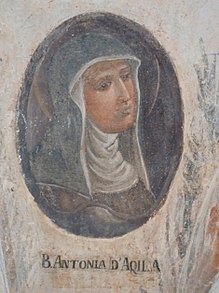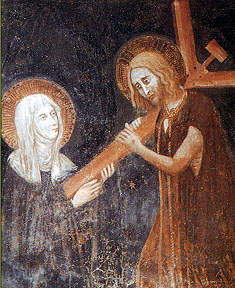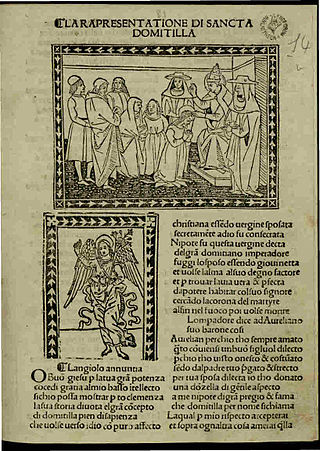This article needs additional citations for verification .(September 2021) |

Antonia of Florence is an Italian blessed. She was abbess of the monastery of Corpus Christi in L'Aquila.
This article needs additional citations for verification .(September 2021) |

Antonia of Florence is an Italian blessed. She was abbess of the monastery of Corpus Christi in L'Aquila.
Antonia was born in Florence in 1401 and married at a young age. [1] She and her husband had one child, a son. [2]
After her husband's death in 1428, she joined the Third Order of Saint Francis. She then joined a women's community in Foligno, where she was soon appointed superior. In 1433, she was transferred to L'Aquila to supervise a monastery, a position she held for thirteen years. Desiring a more austere life, she then entered the Corpus Christi Monastery of the Poor Clares in L'Aquila, where she became abbess. [3] Her spiritual director was John of Capistrano. [4]
Antonia died on 29 February 1472. Many miracles occurred at her tomb and her body has remained incorrupt. She was beatified by Pope Pius IX. [5] in 1847.

The Feast of Corpus Christi, also known as the Solemnity of the Most Holy Body and Blood of Christ, is a liturgical solemnity celebrating the real presence of Christ in the Eucharist; the feast is observed by the Latin Church, in addition to certain Western Orthodox, Lutheran, and Anglican churches. Two months earlier, the institution of the Eucharist at the Last Supper is observed on Maundy Thursday in a sombre atmosphere leading to Good Friday. The liturgy on that day also commemorates Christ's washing of the disciples' feet, the institution of the priesthood, and the agony in the Garden of Gethsemane.

Juliana of Liège, was a medieval Norbertine canoness regular and mystic in what is now Belgium. Traditional scholarly sources have long recognized her as the promoter of the Feast of Corpus Christi, first celebrated in Liège in 1246, and later adopted for the Catholic Church in 1264. More recent scholarship includes manuscript analysis of the initial version of the Office, as found in The Hague, National Library of the Netherlands and a close reading of her Latin vita, a critical edition of which was published in French by the Belgian scholar and current (2023) bishop of Liège, Jean-Pierre Delville.
Itta of Metz, O.S.B. was the wife of Pepin of Landen, Mayor of the Palace of the Kingdom of Austrasia. After his death, she founded the Abbey of Nivelles, where she became a Colombanian nun along with her daughter, Gertrude of Nivelles. Both are honored as saints by the Catholic Church.

The Vallombrosians are a monastic religious order in the Catholic Church. They are named after the location of their motherhouse founded in Vallombrosa, situated 30 km from Florence on the northwest slope of Monte Secchieta in the Pratomagno chain. They use the postnominal abbreviation OSBVall to distinguish themselves from other Benedictines, who generally use the abbreviation OSB.

Maria Laskarina was a Greek Queen consort of Hungary by marriage to King Béla IV of Hungary. She was the daughter of Theodore I Laskaris and Anna Komnena Angelina.

Clare of Montefalco, also called Saint Clare of the Cross, was an Augustinian nun and abbess. Before becoming a nun, Clare was a member of the Third Order of St. Francis (Secular). She was canonized by Pope Leo XIII on December 8, 1881. She differs from Clare of Assisi, a contemporary of St Francis and the founder of an order of Poor Clares.

Saint Humility, known as Saint Roxanne was the founder of the Vallumbrosan Nuns.

Cistercian nuns are female members of the Cistercian Order, a religious order of the Catholic Church.

Sveva da Montefeltro was an Italian beatified nun and noblewoman of the House of Montefeltro. She is venerated by the Catholic Church for her life of devotion despite the hardships she encountered.

Blessed Gertrude of Aldenberg, was a German noblewoman and abbess. She was the daughter of Elizabeth of Hungary and of Louis IV, Landgrave of Thuringia. She became a Premonstratensian canoness regular at the Abbey of Aldenberg, near Wetzlar, in the Diocese of Trier, where she spent much of her life leading the community as its abbess. She was beatified in 1728, her feast is August 13.

Chiara Offreduccio, known as Clare of Assisi, is an Italian saint who was one of the first followers of Francis of Assisi.

Camilla Battista da Varano OSCl,, from Camerino, Italy, was an Italian princess and a Poor Clare nun and abbess. She is venerated as a saint in the Catholic Church.
The Colettine Poor Clares are a reform branch of the Order of St. Clare, founded by Clare of Assisi in Italy in 1211. They follow the interpretation of the Rule of St. Clare established in 1410 by Saint Colette, originally a French hermit and member of the Third Order of St. Francis.
Guglielma or Wilhelmina of Bohemia was an Italian noblewoman, possibly of Czech/Bohemian origin, according to her own assertions the daughter of king Ottokar I of Bohemia. She practiced and preached an alternative, feminized version of Christianity in which she predicted the end of time and her own resurrection as the Holy Spirit incarnate. She is now the unofficial patron saint of Brunate. A painting from ca. 1450 depicting Guglielma blessing Abbess Maddalena Albrizzi and an unknown donor hangs in the Church of San Andrea in Brunate. Barbara Newman has attempted to identify the kneeling figures in the painting as Guglielma's followers, Sister Maifreda da Pirovano and Andrea Saramita, but this is contested.

Hildelith of Barking, also known as Hildilid or Hildelitha, was an 8th-century Christian saint, from Anglo-Saxon England but was of foreign origin.

Antonia Tanini Pulci was an Italian playwright whose works were published in several editions in the fifteenth and sixteenth centuries.
Mattia Ciccarelli, in religious Cristina, was an Italian nun from the Order of Saint Augustine noted for her ecstasies and the reception of the stigmata. The religious was also known for her generous donations to the poor of the Abruzzo region despite being in the monastery.
Camilla Pio di Savoia was born an Italian noblewoman and later founded the first female monastery in Carpi, Italy, Santa Chiara, of which she was elected abbess. Her Cause for Canonization has been opened.

The Abbey of St Caesarius, at first called the abbey or monastery of St John, was a nunnery in the city of Arles in the south-eastern corner of the rampart. It was founded in 512 AD by Saint Caesarius of Arles, after whom it is now named. The abbey was suppressed in the French Revolution. Those that remained of the buildings were later used as a hospice; they are now adandoned.

The Bembo family was a noble Venetian family, part of the Venetian noble families of most ancient origins.